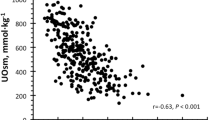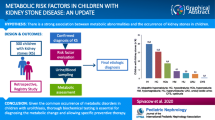Abstract
Published data on the association between calcium oxalate (CaOx) crystallization and kidney stone disease in children are scarce. The aims of this study were to determine CaOx crystallization using the Bonn Risk Index (BRI) in children with urolithiasis in comparison to healthy controls, to evaluate the relationships between BRI and urinary parameters, such as pH, calciuria, oxaluria and citraturia, and to assess the association between BRI and the size of renal stones. We compared the BRI in 142 Caucasian children and adolescents (76 girls, 66 boys) aged 3–18 years with kidney stones and 210 healthy age- and sex-matched controls without urolithiasis. Urinary ionized calcium ([Ca2+]) was measured using a selective electrode, while the onset of spontaneous crystallization was determined using a photometer and titration with 40 mmol/L ammonium oxalate (Ox2−). The calculation of the BRI value was based on the Ca2+:Ox2− ratio. High-resolution renal ultrasonography was carried out to estimate the size of the renal stones. The BRI values were 15-fold higher in children with renal stones than in healthy children without stones. The same trend was shown by BRI/kg body weight (tenfold greater in children with renal stones than in healthy children without stones), BRI/per 1.73 m2 body surface (13-fold greater) and BRI/body mass index (23-fold greater). No association was observed between BRI and the diameter of stones. Children with kidney stones, both males and females, had an increased BRI compared with subjects without urolithiasis. High BRI suggests an association with lower urinary pH, hypercalciuria, hyperoxaluria or hypocitraturia, which are all risk factors of kidney stones. An increased BRI in children, although unrelated to renal stone size, reflects the risk of calcium oxalate crystallization and may indicate early metabolic disorders leading to urolithiasis.


Similar content being viewed by others
References
Pak CY (1998) Kidney stones. Lancet 351:1797–1801
Hoppe B, Leumann E, von Unruh G, Laube N, Hesse A (2003) Diagnostic and therapeutic approaches in patients with secondary hyperoxaluria. Front Biosci 8:437–443
Trinchieri A, Ostini F, Nespoli R, Rovera F, Zanetti G (1999) A prospective study of recurrence rate and risk factors for recurrence after a first renal stone. J Urol 162:27–30
Sutherland JW, Parks JH, Coe FL (1985) Recurrence after a single renal stone in a community practice. Miner Electrolyte Metab 11:267–269
Cameron MA, Sakhaee K, Moe OW (2005) Nephrolithiasis in children. Pediatr Nephrol 20:1587–1592
Kraus SJ, Lebowitz RL, Royal SA (1999) Renal calculi in children: imaging features that lead to diagnoses: a pictorial essay. Pediatr Radiol 29:624–630
Tiselius HG (1997) Risk formulas in calcium oxalate urolithiasis. World J Urol 15:176–185
Kavanagh JP, Laube N (2006) Why does the Bonn Risk Index discriminate between calcium oxalate stone formers and healthy controls? J Urol 175:766–770
Werness PG, Brown CM, Smith LH, Finlayson B (1985) EQUIL 2: a basic computer program for the calculation of urinary saturation. J Urol 134:1242–1244
DeFoor W, Asplin J, Jackson E, Jackson C, Reddy P, Sheldon C, Erhard M, Minevich E (2006) Urinary metabolic evaluations in normal and stone forming children. J Urol 176:1793–1796
Laube N, Schneider A, Hesse A (2000) A new approach to calculate the risk of calcium oxalate crystallization from unprepared native urine. Urol Res 28:274–280
Laube N, Hergarten S, Hesse A (2002) Comparison of a laser-probe and photometric determination of the urinary crystallization risk of calcium oxalate. Clin Chem Lab Med 40:595–599
Laube N, Labedzke V, Hergarten S, Hesse A (2002) Determination of urinary calcium-oxalate formation risk with BONN-Risk-Index and EQUIL applied to a family. J Chem Inf Comput Sci 42:633–639
Lewandowski S, Rodgers AL, Laube N, von Unruh G, Zimmermann D, Hesse A (2005) Oxalate and its handling in a low stone risk vs a stone-prone population group. World J Urol 6:1–4
Porowski T, Zoch-Zwierz W, Wasilewska A, Spotyk A, Konstantynowicz J (2007) Normative data on the Bonn Risk Index for calcium oxalate crystallization in healthy children. Pediatr Nephrol 22:514–520
Kunachowicz H, Nadolna I, Przygoda B, Iwanow K (eds) (1998) Food composition tables. National Food and Nutrition Institute, Warsaw
VanDervoort K, Wiesen J, Frank R, Vento S, Crosby V, Chandra M, Trachtman H (2007) Urolithiasis in pediatric patients: a single center study of incidence, clinical presentation and outcome. J Urol 177:2300–2305
Pietrow PK, Pope JC 4th, Adams MC, Shyr Y, Brock JW 3rd (2002) Clinical outcome of pediatric stone disease. J Urol 167:670–673
Kroovand RL (1997) Pediatric urolithiasis. Urol Clin North Am 24:173–184
Tefekli A, Esen T, Ziylan O, Erol B, Armagan A, Ander H, Akinci M (2003) Metabolic risk factors in pediatric and adult calcium oxalate urinary stone formers: is there any difference? Urol Int 70:273–277
Erbagci A, Erbagci AB, Yilmaz M, Yagci F, Tarakcioglu M, Yurtseven C, Koyluoglu O, Sarica K (2003) Pediatric urolithiasis—evaluation of risk factors in 95 children. Scand J Urol Nephrol 37:129–133
Laube N, Hergarten S, Hoppe B, Schmidt M, Hesse A (2004) Determination of the calcium oxalate crystallization risk from urine samples: the Bonn Risk Index in comparison to other risk formulas. J Urol 172:355–359
Teller WM, Burke EC, Rosevear JW, McKenzie BF (1962) Urinary excretion of acid mucopolysaccharides in normal children and patients with gargoylism. J Lab Clin Med 59:95–101
Bergsland KJ, Kinder JM, Asplin JR, Coe BJ, Coe FL (2002) Influence of gender and age on calcium oxalate crystal growth inhibition by urine from relatives of stone forming patients. J Urol 167:2372–2376
Ricchiuti V, Hartke DM, Yang LZ, Goldman HB, Elder JS, Resnick MI, Marengo SR (2002) Levels of urinary inter-alpha-trypsin inhibitor trimer as a function of age and sex-hormone status in males and females not forming stones. BJU Int 90:513–517
Moe OW, Preisig PA (2006) Dual role of citrate in mammalian urine. Curr Opin Nephrol Hypertens 15:419–424
Halperin ML, Cheema Dhadli S, Kamel KS (2006) Physiology of acid-base balance: Links with kidney stone prevention. Semin Nephrol 26:441–446
Author information
Authors and Affiliations
Corresponding author
Rights and permissions
About this article
Cite this article
Porowski, T., Zoch-Zwierz, W., Konstantynowicz, J. et al. A new approach to the diagnosis of children’s urolithiasis based on the Bonn Risk Index. Pediatr Nephrol 23, 1123–1128 (2008). https://doi.org/10.1007/s00467-008-0786-1
Received:
Revised:
Accepted:
Published:
Issue Date:
DOI: https://doi.org/10.1007/s00467-008-0786-1




